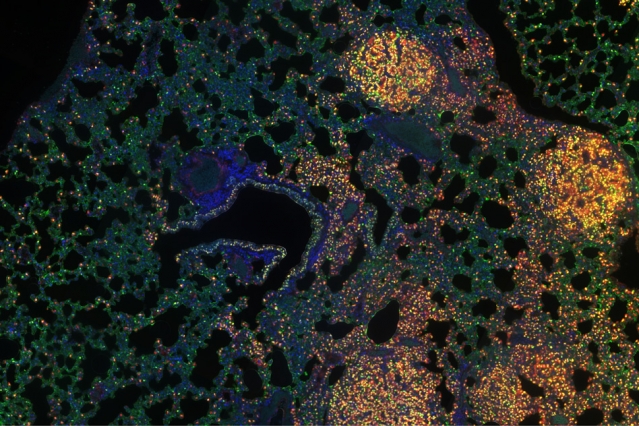 Cancer cells tend to accumulate genetic changes in their DNA that help them grow out of control and often spread throughout the body. Beyond these DNA mutations, cancer cells also exhibit malfunctions in when their genes are turned on or off, called “epigenomic” changes, that help them become more aggressive. While studying these changes, Damon Runyon Fellow Lindsay M. LaFave, PhD, and colleagues at Massachusetts Institute of Technology and Harvard University, discovered that elevated levels of a protein called RUNX2 in human lung tumors predict a worse prognosis—a finding which could lead to new diagnostics and drug targets. RUNX2 is a “transcription factor” that helps regulate the production of other proteins. The researchers identified RUNX2 as a key player in aggressive lung cancer while mapping out the changes that occur in cells’ chromosomes as tumors metastasize.
Cancer cells tend to accumulate genetic changes in their DNA that help them grow out of control and often spread throughout the body. Beyond these DNA mutations, cancer cells also exhibit malfunctions in when their genes are turned on or off, called “epigenomic” changes, that help them become more aggressive. While studying these changes, Damon Runyon Fellow Lindsay M. LaFave, PhD, and colleagues at Massachusetts Institute of Technology and Harvard University, discovered that elevated levels of a protein called RUNX2 in human lung tumors predict a worse prognosis—a finding which could lead to new diagnostics and drug targets. RUNX2 is a “transcription factor” that helps regulate the production of other proteins. The researchers identified RUNX2 as a key player in aggressive lung cancer while mapping out the changes that occur in cells’ chromosomes as tumors metastasize.
The researchers have mapped out an array of structural changes to “chromatin,” the mix of proteins, DNA, and RNA that makes up the chromosomes inside cells. In a study of mouse lung tumors, the researchers identified 11 chromatin states, also called epigenomic states, that cancer cells can pass through as they become more aggressive. “This work provides one of the first examples of using single-cell epigenomic data to comprehensively characterize genes that regulate tumor evolution in cancer,” said Dr. LaFave.
Regulating Gene Function
Every cell in the body contains a complete set of genes necessary to function but not all the genes will be turned on. The epigenome regulates which of these genes will be expressed by attaching proteins and chemical compounds to the DNA. These modifications, which vary by cell type, help to make a lung cell different from a muscle cell, for example. Epigenomic changes are also believed to influence cancer progression.

Image: Isabella Del Priore and Lindsay LaFave
Using a mouse model of lung adenocarcinoma, which closely recapitulates the development of human lung tumors, researchers analyzed the epigenomic changes that occur as tumor cells evolve from early stages to later, more aggressive stages. They also examined tumor cells that had metastasized beyond the lungs.
They uncovered 11 different chromatin states, based on the locations of epigenomic alterations and density of the chromatin. Within a single tumor, individual lung cancer cells could be characterized by any of the 11 states, suggesting that cells can follow different evolutionary pathways.
As the structure of tumor cells’ chromatin changed, different genes were activated allowing the cells to lose their original identity as lung cells. Eventually many of the cells also gained the ability to leave their original locations and seed new, distant tumors. Much of this process was controlled by a transcription factor called RUNX2, which was elevated in more aggressive mouse tumors and human tumors suggesting that it could serve as a biomarker for predicting patient outcomes.
Transcription factors can bind to DNA and initiate the copying of a gene into messenger RNA, essentially controlling which genes are transcribed into proteins. In more aggressive cancer cells, RUNX2 promotes the transcription of genes for proteins that are secreted by cells. These proteins help remodel the environment surrounding the tumor to make it easier for cancer cells to escape.
The researchers also found that these aggressive, premetastatic tumor cells resembled tumor cells that had already metastasized, suggesting that these cells changed their chromatin to look like a metastatic cell before they migrated out into the environment.
“We believe they undergo an epigenetic change in the primary tumor that allows them to become migratory and then seed in a distal location like the lymph nodes or the liver,” said Drl LaFave. “The RUNX positive state was very highly predictive of poor survival in human lung cancer patients,” she said. “We’ve also shown the inverse, where we have signatures of early states, and they predict better prognosis for patients.”
The researchers are also seeking other potential targets among the epigenomic changes that they identified in more aggressive tumor cell states.
This work was published in Cancer Cell.
Read more: MIT News







